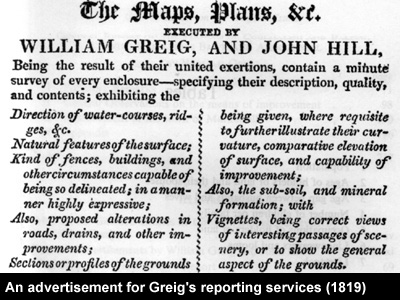
When William Greig made his investigation into the workings of the Gosford Estates in County Armagh, he made considerable investigation into the manufacture of textiles on the Estate, particularly the growth of flax and manufacture of linen.
Early in his report, published in 1821, Greig tabulated the occupations pursued on the Estate. Among the occupations listed are weaver, flax dresser, millwright, flax drier, linen buyer, linen merchant and cotton spinner. In fact, 88.1 per cent of the occupations listed had some relation to the manufacture of cotton or linen. However, this figure is somewhat misleading as more than half the landowners on the Estate had no other occupation than agriculture.
According to Greig's estimates, there were three hundred and thirty seven looms operation on the Gosford Estates at Baleek and Coolmalish but very few families had more than one loom, -- the production of textiles was of secondary importance to agricultural production. A small number of cotton weavers lived on the Estate and worked at the cotton spinning works of William Atkinson at Glenanne. Greig commented that cotton spinning was a sound occupation but that it was little practised on the Gosford Estates due to a lack of cotton looms. He suggested Lord Gosford might consider purchasing some cotton looms and leasing them to his tenants to augment their industry.
Among the textile workers the most prosperous on the Estate were William Beard, the linen buyer, and James Stewart, the linen merchant. William Beard farmed some seventeen acres and had a full compliment of farm animals and buildings. James Stewart farmed fifty acres, retained five servants and had recently built a new house at a cost of approximately £1,500.
Greig described the tenants of the Estate as "generally industrious" and the excellent linen markets at Armagh and Tandragee encouraged their industry. The flax purchased at Tandragee was generally considered to be some of the finest linen exported to mainland Britain. Greig remarked,
Irish linen manufacture reached an early zenith in the sixteenth century but since then had gone into decline. At the time when Greig was reporting the linen industry in mainland Britain and further afield had been boosted by embracing the industrial revolution. By contrast Irish linen manufacture was very much rural in nature and of secondary importance to agricultural activities. Greig foresaw a gloomy future,
His pessimism was not wholly without foundation. Even in the years in which he had been compiling his report Greig had witnessed firsthand the precarious nature of Irish agriculture. Bad weather and inadequate harvests left many starving and aided the spread of disease. An epidemic of Typhus Fever swept through the Markethill district in 1818 as numerous headstones in the local churchyards testify.
Grieg had another reason for advocating the extension of the textile industry among the tenants. Much of his report reads as a warning against the practice of subdividing land. In families exclusively dependent upon agriculture, farmland had to be divided among sons exacerbating the hardships of each successive generation. In families where textiles and agriculture were both in operation the eldest son could inherit the farm while the younger sons could continue with the manufacture of linen and cotton.
Greig's prediction was pretty accurate. Linen and cotton continued in decline and its manufacture was confined to factory output, though it continued to make its presence felt in the Markethill district.
REFERENCES
Greig, W, General Report on the Gosford Estates in County Armagh with an introduction by FML Thompson and D Tierney (Belfast, 1976)
